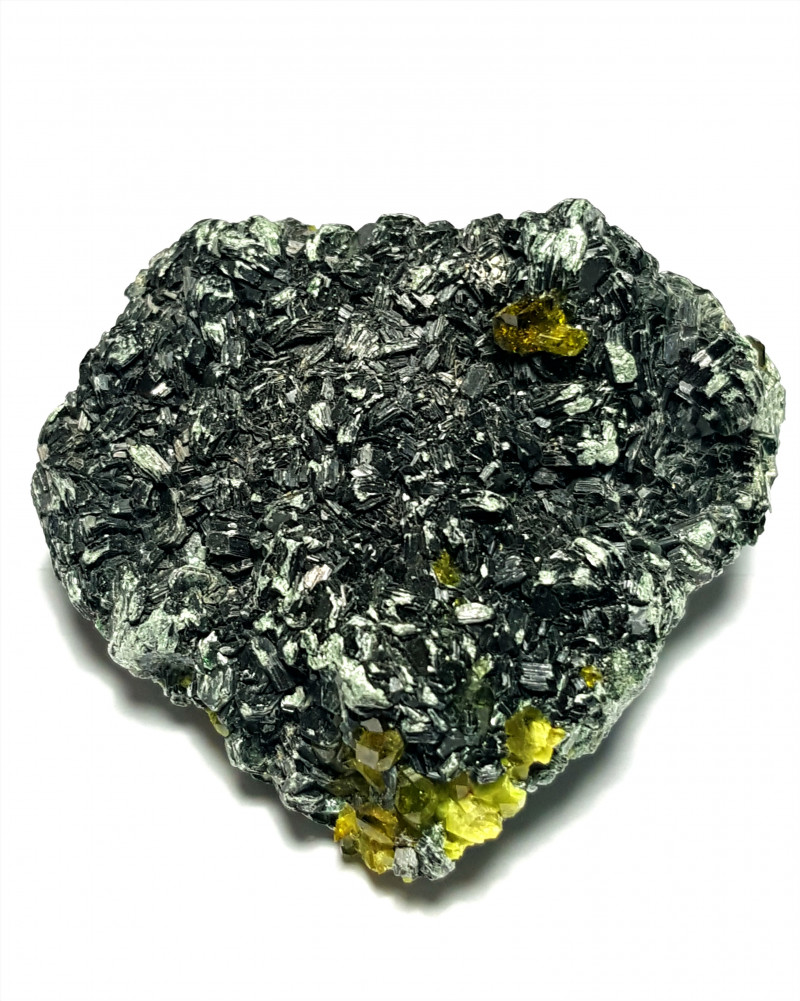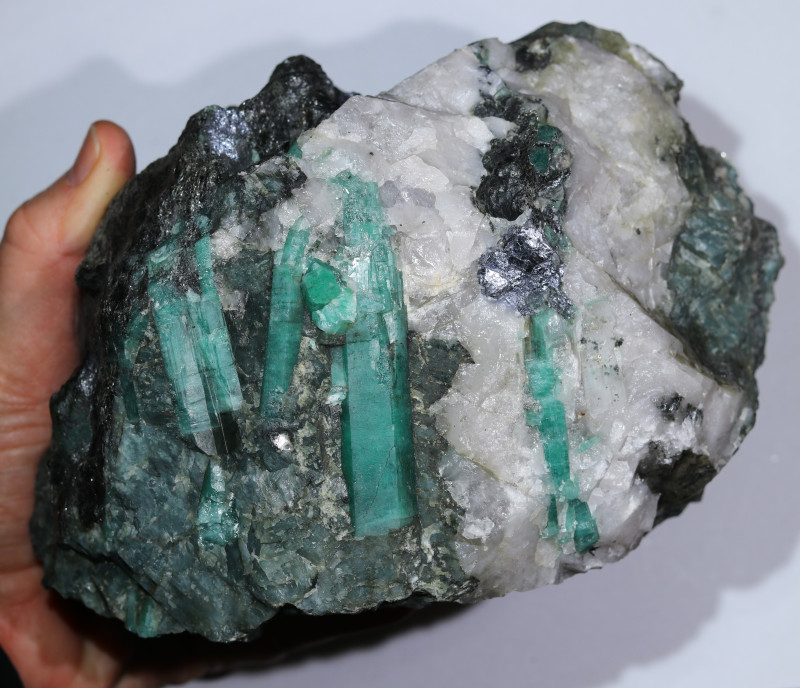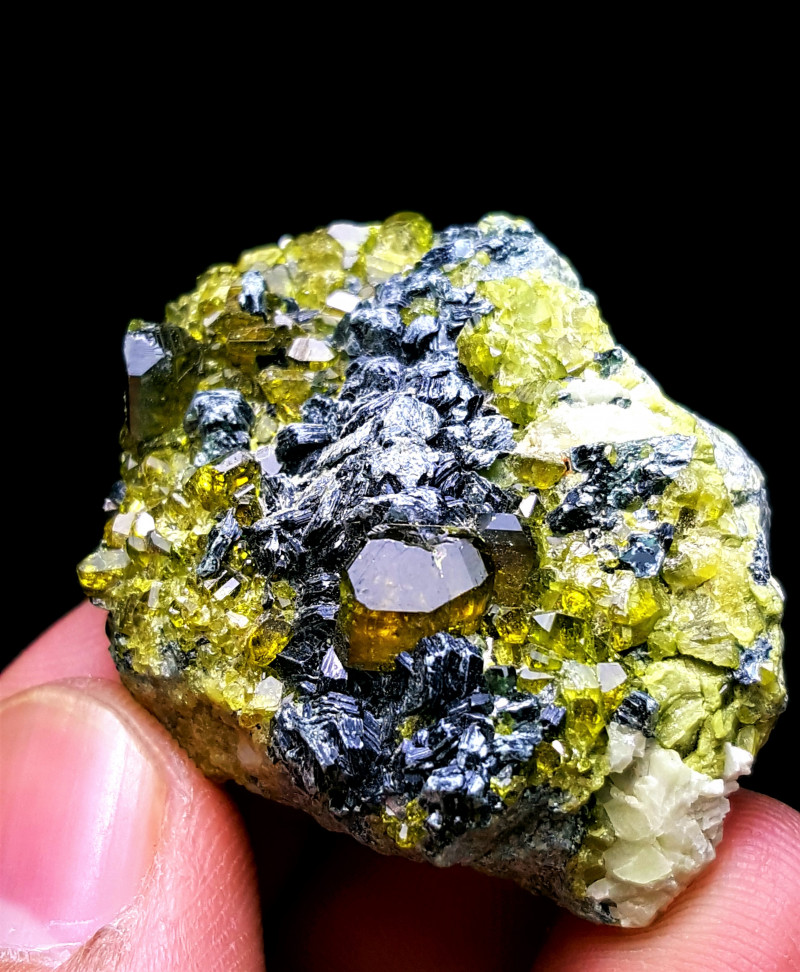
Biotite Gemstone: Properties, Meanings, Value & More
 Biotite is a mica mineral known for being a part of rocks that contain emeralds and other valuable gemstones. But is biotite a gemstone? That depends on who you ask, since some would say it’s not an individual stone at all.
Biotite is a mica mineral known for being a part of rocks that contain emeralds and other valuable gemstones. But is biotite a gemstone? That depends on who you ask, since some would say it’s not an individual stone at all.
The International Mineralogical Association (IMA), an esteemed group that has worked to standardize mineral nomenclature, once considered biotite a single mineral species.
That changed when the IMA announced biotite was a mineral group (not species) in 1998. Therefore, to many mineralogists, even the answer to “Is biotite a crystal?” is technically no.
Here, we’ll still consider biotite an individual stone, though we’ll break down the mineral group as well.
Now, is biotite rare or common? Biotite is one of the most common mica minerals, along with muscovite. Many common rocks you may come across with flashes of sparkle contain biotite.
Today, we’ll tell you all about the biotite gemstone, from its mineral properties to its healing benefits and prices.

About Biotite Stone
Biotite is a dark, glittery stone of many names. The most common nicknames are “black mica” and “iron mica, though “iron mica” is also used for iron-rich biotite stones and a flaky type of hematite. Other biotite monikers include:
Dark mica
Biopyribole
Katzengold
Meroxen / Meroxene
Odenite / Oderite / Odite
The stone is fundamental to many rocks, notably schists containing the precious gemstone emerald.
Astrologically, biotite is a zodiac stone for Scorpio or Aquarius and harmonizes with the number 4 in numerology.
Some important industrial biotite uses exist outside the gemstone and astrology realms.
What is Biotite Used for?
The primary use of biotite is in aging rocks. Scientists use biotite to identify a rock’s minimum age and the temperature changes it went through, all through potassium-argon or argon-argon dating.
Additionally, biotite resists breaking down due to moisture, electricity, temperature, or light, increasing its value industrially.
Like all mica, biotite can be ground easily. Ground biotite may be added to:
Paint — extends longevity and creates a water-resistant coating
Rubber & plastic — increases durability & lowers the cost of production
Drywall & gypsum board — insulates heat
Car paint — adds pearlescent sheen
Electronics — insulates heat and electricity
Drilling fluid — prevents fluid loss from porous stones
Biotite is a common water-resistant, non-stick coating on tar paper, rolled roofing, and asphalt shingles.
The crystal’s birefringence also comes in handy for wave plates, a device used for optical mineral identification by altering light wave polarization.
Speaking of properties like birefringence, what are the characteristics of biotite?

Biotite Specifications & Characteristics
As a phyllosilicate of potassium, magnesium, iron, aluminum, and hydroxide, the biotite formula is approximately K(Mg,Fe)3AlSi3O10(F,OH)2.
The biotite mineral group is a subgroup within the mica family. It’s also called the biotite-phlogopite series. Group members phlogopite and annite form a series, with annite on the iron-dominant side and phlogopite on the magnesium-dominant side. Aluminum-rich members include eastonite and siderophyllite.
Minerals in the biotite group are potassium-rich phyllosilicates composed of weakly bound sheets. Biotite can be massive or platy (layered with thin sheets). Stacked sheets are called “books.”
Though some full crystals have been found, most biotite is seen as tiny flakes within rocks, which can create a glittery effect.
Below are the remaining biotite mineral properties:
Mineral family: Mica
Mohs hardness: 2.5-3
Color: Usually black; Greenish-brown, dark brown, blackish-brown, dark green, yellow
Crystal structure: Monoclinic
Luster: Vitreous (glassy) to pearly
Transparency: Transparent to opaque
Refractive index:
Density: 2.7-3.3
Cleavage: Perfect basal on [001]
Fracture: Uneven
Streak: Grayish-white, gray, or white
Luminescence: None?
Pleochroism: Present, moderate to strong in colorless to brown or brown to yellowish-brown to greenish-brown
Birefringence: 0.03-0.07
 Pictured above: Emerald in biotite specimen
Pictured above: Emerald in biotite specimen
Biotite in Other Gemstones
Most of the time, biotite isn’t seen as an individual stone, but rather attached to (as a matrix) or inside of (as an inclusion) other gemstones.
Most notably, biotite crystals are present as inclusions in emeralds. These inclusions often appear as tiny black specks. This is most common in emeralds that grow on biotite schists, particularly in emeralds from Ethiopia and Australia.
Another notable gemstone that may contain biotite inclusions is sapphire. Sri Lankan and Tanzanian sapphires are known for containing flakes or crystals of biotite.
Other popular gemstones you may see with biotite inclusions include:
In terms of metals, is gold found in biotite? Sort of and sometimes.
After forming, biotite may alter into chlorite and muscovite. This alteration and reaction process can lead to native gold as a byproduct.
 Image credit: Rob Lavinsky, iRocks.com – CC-BY-SA-3.0
Image credit: Rob Lavinsky, iRocks.com – CC-BY-SA-3.0
Biotite Meaning & History
Biotite symbolizes self-reflection, protection, and adaptability. The crystal is attuned to the air element, evoking mental clarity and emotional balance. Biotite is also a planetary star stone for Mercury, the planet of communication and intellect.
History
Mica has been in use since prehistoric times, as evidenced by mica found in cave paintings dating back to 40,000 to 10,000 BC.
Though biotite has likely been known and used since those times, its name didn’t come until the 1800s. German mineralogist Johann Friedrich Ludwig (or J.F.L.) Hausmann named the mineral “biotite” in 1847.
Hausmann chose the name “biotite” to honor French physicist Jean-Baptiste Biot. Biot was known for his award-winning scientific research, including studying mica’s optical properties and discovering how to make a magnetic field via electrical current and wire.
As mentioned up top, mineralogists considered biotite an individual mineral species until 1998, when the IMA announced biotite was a mineral group instead. However, mineralogists still use “biotite” when referring to any dark-colored micas they come across but haven’t analyzed yet.

Biotite Healing Properties
Biotite’s coloring and energies give it powers as a healing stone. Black mica, like other black gemstones, inherently emits protective, grounding energies. Meanwhile, brown mica joins other brown gems in promoting stability and resilience.
Both black and brown crystals serve as chakra stones for the root (or base) chakra. When biotite opens this chakra, it brings you a secure foundation for growth.
What about the biotite crystal benefits for physical and emotional healing?
Physical Healing
Crystal healers use biotite for shielding electromagnetic radiation, often recommending you place the crystal beside your computer.
Did you know that minerals play a crucial role in both alternative medicine and traditional modern medicine? Biotite is a perfect example, as it contains nutrients we need like magnesium, potassium, and zinc, and iron.
In Ayurvedic medicine, biotite is crushed for Abhrak Bhasma, a classic preparation used for various treatments, including respiratory and . The mineral is also extremely common in South Asian Siddha and Rasashastra formulations.
In traditional medicine, scientists have prepared Abhrak by heating, rapid cooling, and burning biotite mixed with other substances. Research has shown the resulting drug kill both parasitic worms and microorganisms (i.e. bacteria, viruses), along with slowing glucose absorption in those with diabetes, for example.
Emotional Healing
Many purported emotional benefits of biotite tie to its physical properties. For instance, the shiny biotite luster reflects (pun intended) the way it encourages introspection. Similarly, the stone is also said to broaden your perspective, illuminating the world’s hidden truths.
Biotite’s flexible tenacity is believed to promote adaptability and compassion for others, particularly when you’re frustrated about plans changing. Lastly, the crystal’s insulating properties can provide protection from negativity.
Is biotite valuable beyond crystal healing? Definitely! The specific value of each specimen depends on its value factors (a.k.a. gemstone properties).
 Image credit: Fred Kruijen | Creative Commons Attribution-Share Alike 3.0 Netherlands license
Image credit: Fred Kruijen | Creative Commons Attribution-Share Alike 3.0 Netherlands license
Biotite Gemstone Properties
The value of an individual biotite stone depends on where it falls in terms of color, cut, clarity, and carat weight.
Color
If you’ve seen other mica minerals before (like muscovite or lepidolite), you’re probably used to them having pale coloring. So why is biotite black or dark-colored? It comes back to that “iron mica” nickname — yep, the dark biotite color comes from iron.
Weathering, however, can lead to slightly paler hues like yellow. Biotite with medium-shade colors are better for seeing the stone’s strong pleochroism.
Cut
Though stones containing biotite inclusions — like quartz or topaz to name a couple — may be faceted, biotite itself is simply too delicate to be faceted.
Instead, biotite may be cut into cabochons, tumbled stones, or beads. Attractive specimens may also be sold in their raw, uncut state. Large sheet slabs are somewhat popular in decor.
Clarity
Clarity measures the degree of visible inclusions in a gem. Though clarity isn’t as important in opaque or all-black biotite, it can affect the appearance of translucent, transparent, or slightly lighter-colored specimens.
One of the most common inclusions in biotite is zircon; you may even see pleochroic “halos” around zircon crystals inside the stone. Biotite with needle-like inclusions of rutile and sometimes titanite may be called “sagenitic biotite.”
Carat Weight & Size
Most biotite stones sold in the gemstone sphere are cut from massive material or small crystals. The currently largest individual biotite crystals ever recorded were sheets from Iveland, Norway, that had an area of roughly 75 square feet (7 meters squared).
If you’re wondering how those huge sheets formed, that’s up next!

Biotite Formation & Sources
Biotite forms through a couple of processes and various environments, as the pressure and temperature ranges for its formation are fairly broad.
Most often, sedimentary rocks rich in clay undergo metamorphism after being buried, with the metamorphic changes altering minerals into biotite. Some minerals that can transform into biotite include augite, hornblende, and wernerite.
What is biotite found in? Biotite is found in lots of igneous and metamorphic rocks. That’s because biotite is a rock-forming mineral, meaning it’s usually an essential part of the rock’s composition. Some examples of rocks containing biotite are pegmatites, granite, and rhyolite.
You might also see an igneous rock called “glimmerite” or “biotitite” that’s almost completely made up of biotite or phlogopite.
Common associated minerals are simpsonite and chlorite. The “black mica” stone is also often found near muscovite, the “white mica” stone.
Mining Locations
Biotite and muscovite are the most common micas, so there are lots of sources. World-class locales include Québec, Canada, plus the US states of New Jersey and Pennsylvania.
Other significant biotite sources are:
Australia
China
Germany
Italy
Russia
Sweden
USA (Colorado, Connecticut, Massachusetts, New York, North Carolina, Virginia)
Next, how much do biotite stones cost?
 Pictured above: Epidote and biotite specimen
Pictured above: Epidote and biotite specimen
Biotite Price & Value
Luckily, biotite’s abundance makes it an affordable gem. Biotite rough is probably the most affordable option; even biotite specimens containing emerald go for $0.04-$0.60 per carat at wholesale.
Beaded strands of biotite are usually around $10 each. Finished beaded bracelets start at $10 and go up to around $50, unless the piece includes pricier metal or gems.
Tumbled stones typically start around $5 and can reach $30 or higher for stones with more valuable gems inside.
Before we wrap up, let’s discuss gemstone care.
Biotite Care and Maintenance
Proper handling techniques are important to take care of your biotite and your own health. Inhaling mica dust is dangerous, so it’s best to keep rough specimens (that can flake off) on display. Polished stones don’t pose much of a risk.
If you come across biotite jewelry that isn’t beaded, we recommend protective settings to protect the fragile stone.
Biotite will dissolve in both acidic and basic (alkaline) solutions, though it’ll dissolve faster in acidic solutions. Putting water on biotite can damage the stone as well. Many experts recommend cleaning the stone with a dry electric toothbrush with soft bristles.
See Beyond with Biotite!
Whether or not you’ve heard of biotite before, it’s clear that this mineral is a dark, glittering wonder. It may not be rare, but biotite offers unique benefits both industrially and spiritually. If you’re looking to gain a greater perspective on yourself and the world, try a biotite crystal!
Search the Gemstone Encyclopedia
Related Auctions
Related Articles
Originally the Birthstones or gemstones were associated with a zodiac sign or the month of a individuals birth. Find out what your stone is and view the stones we have for sale
8th Feb 2021
There are dozens of quartz and chalcedony gems with various colors and patterns. Learn all about quartz properties and every type of quartz, from amethyst and agate to plasma and phantom quartz!
15th Oct 2020
Hackmanite is a pink to violet sodalite gem known for its unique color-change and luminescence. Learn why hackmanite is special, from its rare qualities to the types of hackmanite jewelry available.
28th Mar 2018
Latest Articles
Friedelite is an uncommon pink, red, or brown manganese silicate mineral best known from New Jersey and South Africa. Learn the prices, properties, uses, and history of friedelite gemstones.
23rd Dec 2024
Shortite is a rare mineral and rarer gemstone, usually found as colorless or yellow wedge-shaped crystals. Learn the value, history, and properties of shortite in this guide!
9th Dec 2024
Senarmontite is an uncommon antimony mineral mostly used industrially but occasionally collected as rare gems or pearly crystals. Find out all of the traits, uses, prices, and history of senarmontite.
27th Nov 2024
Article Categories
How To's is where you will find helpful articles from gem Rock Auctions on how to cut gemstones, select gemstones and buy gemstones.
9 Articles




